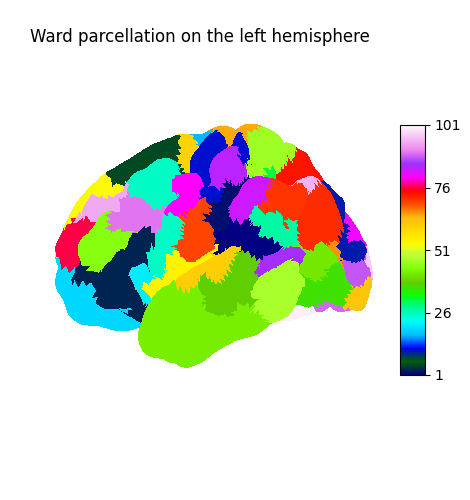Note
Go to the end to download the full example code.
Pairwise surface alignment.¶
In this tutorial, we show how to align surface data from two subjects using a pairwise alignment method. We project the data on the fsaverage5 surface and learn a piecewise mapping from one subject to the other using ward clustering.
We mostly rely on python common packages and on nilearn to handle functional data in a clean fashion.
Retrieve the data¶
In this example we use the IBC dataset, which include a large number of different contrasts maps for 12 subjects. We download the images for subjects sub-01 and sub-04 (or retrieve them if they were already downloaded) Files is the list of paths for each subjects. df is a dataframe with metadata about each of them.
[get_dataset_dir] Dataset found in /home/runner/nilearn_data/ibc
Project the data on the fsaverage5 surface¶
We project the data on the fsaverage5 surface, using the fsaverage5 surface template.
from nilearn.datasets import load_fsaverage, load_fsaverage_data
from nilearn.maskers import SurfaceMasker
from nilearn.surface import SurfaceImage
fsaverage_meshes = load_fsaverage()
def project_to_surface(img):
"""Util function for loading and projecting volumetric images."""
surface_image = SurfaceImage.from_volume(
mesh=fsaverage_meshes["pial"],
volume_img=img,
)
return surface_image
from nilearn.image import concat_imgs
source_train = concat_imgs(
df[(df.subject == "sub-01") & (df.acquisition == "ap")].path.values
)
target_train = concat_imgs(
df[(df.subject == "sub-04") & (df.acquisition == "ap")].path.values
)
surf_source_train = project_to_surface(source_train)
surf_target_train = project_to_surface(target_train)
masker = SurfaceMasker().fit([surf_source_train, surf_target_train])
Compute and plot a parcellation¶
We compute a parcellation for local alignments with
get_labels
and plot it on the surface using nilearn.
from nilearn import plotting
from fmralign import PairwiseAlignment
from fmralign.embeddings.parcellation import get_labels
labels = get_labels(
[surf_source_train, surf_target_train],
n_pieces=100,
masker=masker,
clustering="ward",
)
clustering_img = masker.inverse_transform(labels)
plotting.plot_surf_roi(
surf_mesh=fsaverage_meshes["pial"],
roi_map=clustering_img,
hemi="left",
view="lateral",
title="Ward parcellation on the left hemisphere",
)
plotting.show()

/home/runner/work/fmralign/fmralign/fmralign/embeddings/parcellation.py:82: UserWarning: Overriding provided-default estimator parameters with provided masker parameters :
Parameter smoothing_fwhm :
Masker parameter None - overriding estimator parameter 4.0
parcellation.fit(images_to_parcel)
/home/runner/work/fmralign/fmralign/.venv/lib/python3.12/site-packages/scipy/sparse/_index.py:210: SparseEfficiencyWarning: Changing the sparsity structure of a csr_matrix is expensive. lil and dok are more efficient.
self._set_arrayXarray(i, j, x)
/home/runner/work/fmralign/fmralign/.venv/lib/python3.12/site-packages/sklearn/cluster/_agglomerative.py:321: UserWarning: the number of connected components of the connectivity matrix is 2 > 1. Completing it to avoid stopping the tree early.
connectivity, n_connected_components = _fix_connectivity(
/home/runner/work/fmralign/fmralign/examples/plot_surf_alignment.py:87: DeprecationWarning: The `darkness` parameter will be deprecated in release 0.13. We recommend setting `darkness` to None
plotting.plot_surf_roi(
Fitting the alignment operator¶
We use the PairwiseAlignment
class to learn the alignment operator from one subject to the other.
We select the Procrustes method to compute
a rigid piecewise alignment mapping and the ward clustering method to
parcellate the cortical surface.
data_source_train = masker.transform(surf_source_train)
data_target_train = masker.transform(surf_target_train)
alignment_estimator = PairwiseAlignment(
method="procrustes",
labels=labels,
)
# Learn alignment operator from subject 1 to subject 2 on training data
alignment_estimator.fit(data_source_train, data_target_train)
/home/runner/work/fmralign/fmralign/fmralign/alignment/utils.py:212: UserWarning:
Some parcels are more than 1000 voxels wide it can slow down alignment,especially optimal_transport :
parcel 17 : 1909 voxels
warnings.warn(warning)
Projecting the left-out data¶
Let’s now align a left-out audio contrast from sub-01 to sub-04. We project the data on the surface and apply the learned alignment operator.
surf_audio_source = project_to_surface(
df[
(df.subject == "sub-01")
& (df.condition == "audio_sentence")
& (df.acquisition == "pa")
].path.values
)
surf_audio_target = project_to_surface(
df[
(df.subject == "sub-04")
& (df.condition == "audio_sentence")
& (df.acquisition == "pa")
].path.values
)
audio_source_data = masker.transform(surf_audio_source)
aligned_target_data = alignment_estimator.transform(audio_source_data)
surf_aligned = masker.inverse_transform(aligned_target_data)
Visualizing the alignment in action¶
We interpolate between the source and aligned images to visualize the alignment process. Notice how the individual idiocyncracies of the source subject are progressively removed.
from copy import deepcopy
import matplotlib.pyplot as plt
from matplotlib.animation import FuncAnimation
fsaverage_sulcal = load_fsaverage_data(
mesh="fsaverage5",
data_type="sulcal",
mesh_type="inflated",
)
plotting_params = {
"bg_map": fsaverage_sulcal,
"hemi": "left",
"view": "lateral",
"colorbar": True,
"alpha": 0.5,
"bg_on_data": True,
"vmax": 3,
"vmin": -3,
"cmap": "coolwarm",
"darkness": None,
}
def interpolate_surf_image(surf_img1, surf_img2, alpha=0.5):
"""Interpolate two surface images."""
# Create a new surface image with the same mesh as the input
surf_img_interpolated = deepcopy(surf_img1)
# Interpolate the data
for hemi in ["left", "right"]:
surf_img_interpolated.data.parts[hemi] = (
surf_img1.data.parts[hemi] * (1 - alpha)
+ surf_img2.data.parts[hemi] * alpha
)
return surf_img_interpolated
# Create figure
fig = plt.figure(figsize=(10, 8))
# Define a function to update the figure for each frame
def update(frame):
plt.clf()
if frame <= 10:
# Interpolation frames (0-10)
alpha = frame / 10
surf_interpolated = interpolate_surf_image(
surf_audio_source, surf_aligned, alpha=alpha
)
plotting.plot_surf_stat_map(
surf_mesh=fsaverage_meshes["pial"],
stat_map=surf_interpolated,
figure=fig,
**plotting_params,
)
plt.suptitle(
f"Interpolated audio sentence alpha={alpha:.1f}", fontsize=16
)
else:
# Target image (frame 10)
plotting.plot_surf_stat_map(
surf_mesh=fsaverage_meshes["pial"],
stat_map=surf_audio_target,
figure=fig,
**plotting_params,
)
plt.suptitle("Target image", fontsize=16)
return [fig]
# Create the animation
anim = FuncAnimation(fig, update, frames=range(12), interval=300, blit=True)
/home/runner/work/fmralign/fmralign/examples/plot_surf_alignment.py:204: UserWarning: Meshes are not identical but have compatible number of vertices.
plotting.plot_surf_stat_map(
Total running time of the script: (1 minutes 12.171 seconds)